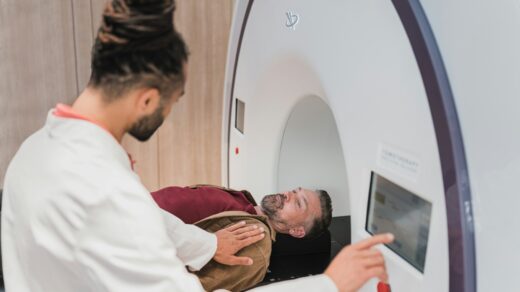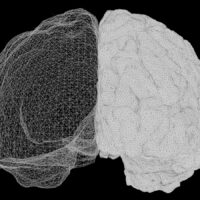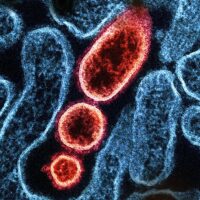Diarrhea is one of the most common symptoms. It affects 3–5% of the total population. It is defined as the abnormal passage of three or more loose or liquid stools per day for more than four weeks or for daily stool weight above 200 grams. Symptom-based clinical definitions may overlap with functional bowel disorders like IBS, which does not usually increase stool weight. Given that IBS affects 9–12% of the population, there is a risk of over investigating patients presenting with diarrhea. On the other hand, newly developed diarrhea can represent more ominous disorders such as colonic neoplasia, so chronic diarrhea is a challenging diagnosis because a myriad of disorders can cause it.
Etiology of Chronic Diarrhea
Acute diarrhea is often infectious in origin. Diarrhea persisting beyond four weeks usually represents a noninfectious disorder, but microorganisms may be causative in some instances. Chronic infectious diarrhea is generally seen in persons traveling to or coming from developing or tropical countries, natives of such areas, immunocompromised patients, hospitalized patients with Clostridium difficile infections, and patients with Whipple’s disease. In HIV-infected individuals, the prevalence of chronic diarrhea was higher in persons with low CD4 lymphocyte counts (<200/mm³, especially < 50 cells/mm³). The main therapeutic strategy for immunocompromised patients is to treat the underlying immunologic problem, including the use of highly active antiretroviral therapy (HAART) for HIV patients. Organisms responsible for infection in this category include opportunistic infections such as Cryptosporidium, Microsporidium, Cyclospora, Mycobacterium avium-intracellulare, and cytomegalovirus.
Diagnostic and Therapeutic Approach
The Topic reviews the bacterial, parasitic, fungal, and viral causes of chronic diarrhea and outlines a general approach to investigation. The first line of investigation is taking a thorough history and also examining the stool character that may give an idea of the various causes and other investigative possibilities. This is followed by investigation into the nature of the stool, which may reveal the infective causes in the majority of cases. Other methods for chronic diarrhoea in travelers, HIV-infected patients, and also those suspected of Whipple’s disease are given. This discussion also covers chronic (infectious?) diarrheal diseases, including tropical sprue and Brainerd diarrhea.
Bacterial Etiologies of Chronic Diarrhea
Common Bacterial Causes
Several bacteria commonly responsible for acute diarrhea in immunocompetent hosts can cause more serious or protracted infection in immunocompromised hosts. These bacteria include Salmonella spp., Yersinia enterocolitica, Campylobacter spp., Plesiomonas shigelloides, and Vibrio parahaemolyticus. Gastrointestinal tuberculosis continues to be a problem in underprivileged regions, in immigrants from developing nations, and in HIV-infected individuals. Mycobacterium avium-intracellulare is another cause of chronic diarrhea in HIV-infected patients but particularly in patients whose CD4 lymphocyte count is less than 50/mm³. The detailed clinical presentation, diagnosis, and treatment of these mycobacterial infections are beyond the scope of this text but are discussed in detail in other resources.
Clostridium difficile Infection
Clostridium difficile is an anaerobic bacterium and one of the major nosocomial pathogens, usually acquired by hospitalized patients, especially after the use of broad-spectrum antibiotics like clindamycin, cephalosporins, or quinolones. The spectrum of conditions involving infection with C. difficile can be asymptomatic carriage to severe conditions such as pseudomembranous colitis. Symptoms include abdominal pain, cramping, fever, and leukocytosis. The stools are rarely bloody. Diagnosis is usually made using enzyme immunoassays for C. difficile toxin A or B, and colonoscopy may show classic pseudomembranes. An immediate cessation of the offending antibiotic is critical to treatment, while metronidazole and vancomycin are the drugs of choice for those cases that are severe or continue beyond a few days.
Whipple’s Disease
Whipple’s disease is an infectious disease caused by Tropheryma whipplei. Although described as rare, it infects a worldwide population with a higher incidence in middle-aged Caucasian males. The mode of transmission has not been well described, but fecal–oral spread has been one theory postulated for this illness. This disease has a prodromal phase, which includes arthralgia/arthritis, followed by a steady-state phase with weight loss and/or chronic diarrhea. Many years may elapse from the prodromal to the steady-state phase, although this may be hastened in immunosuppressed hosts. About 15% of patients present without classic symptoms. Recent reports illustrate a broader spectrum of infection due to T. whipplei than previously appreciated.
PCR Detection and Treatment of Whipple’s Disease
Detection of Tropheryma whipplei
Polymerase chain reaction presently detects Tropheryma whipplei in several types of tissues and body fluids: gastric and small bowel biopsies and also stools. The most sensitive diagnostic technique at the present time is the quantitative real-time PCR assay targeting repeated sequences of T. whipplei with fluorescent-labeled oligonucleotide probes. Controls are to be systematically added during the PCR-amplification process: positive and negative controls to validate the process. Cultivation of T. whipplei is possible by use of mammalian cell cultures and axenic medium, but availability is limited. Serologic tests are not available for the diagnosis of classic Whipple’s disease.
Treatment
Whipple’s disease was uniformly fatal before the advent of antibiotics. Treatment is empirical and consists of an initial 2-week parenteral regimen with ceftriaxone or streptomycin plus penicillin G followed by 1–2 years of oral trimethoprim-sulfamethoxazole. Recent studies indicate that bactericidal activity in vitro was exhibited by doxycycline and hydroxychloroquine. In cases with neurologic involvement, either high-dose oral sulfamethoxazole or sulfadiazine is added. There is no established marker that indicates the duration of treatment, but an 18-month regimen is suggested. Long-term follow-up for optimal management is very essential.
Small Intestinal Bacterial Overgrowth (SIBO)
SIBO means an inappropriate bacterial population of the small intestine. Symptoms include malabsorption and diarrhea. Diagnosis is usually suggested by findings in hydrogen breath tests or small-bowel culture with colony counts >105/ml. Basic treatment will involve removal of underlying conditions, nutritional support, and suppression of bacterial proliferation. There is no clear-cut concept regarding the best approach for treatment as there is a lack of sensitive diagnostic and therapeutic means.
Parasitic Causes of Chronic Diarrhea
Protozoan Parasites
Giardiasis: Giardiasis, caused by Giardia duodenalis, is one of the most common parasitic diarrheas worldwide. Contaminated water and food are vehicles of transmission. In developing countries, prevalence may reach 20% among children under age 10 years. Among travellers, infection rates range from 1-3%. Diagnosis commonly relies on examination of faeces specimens, enzyme immunoassays, and PCR improve diagnostic yield compared with conventional microscopy.
Diagnostic and Therapeutic Approaches
Detection: Many parasites require multiple stool samples. Special stains or concentration protocols may be needed. Enzyme immunoassays and real-time PCR are superior to older methods of detection. Stool samples preserved in ethanol may be transported for analysis of DNA.
Treatment Treatment depends on the parasite. For protozoans, the typical treatment is with metronidazole or tinidazole.
Giardiasis
Epidemiology and Transmission
Giardia duodenalis (formerly G. lamblia or G. intestinalis) is a cosmopolitan parasite and a leading cause of parasitic diarrhea in humans worldwide. Infection usually results from direct fecal-oral contact, though water and food are common vectors. It has been associated with hypogammaglobulinemia, protein-calorie malnutrition, gastrectomy, or immunosuppressive medication but has no increased incidence in HIV-infected individuals.
Clinical Features
Clinical spectrum-asymptomatic carriage to acute diarrhea to severe chronic diarrhea with intestinal malabsorption. Chronic giardiasis: profound malaise, epigastric discomfort, headache, and steatorrhea. Recurrent diarrhea after treatment is due to lactose intolerance rather than reinfection.
Diagnosis
Diagnosis is usually by stool examination for trophozoites using wet mount or trichrome stain. More sensitive methods include immunofluorescence, ELISA, and real-time PCR. When stool tests are negative, small-bowel aspiration or biopsies may be required.
Treatment
Adults: Metronidazole 250 mg po tid for 7 days.
Children: Metronidazole 5 mg/kg po tid for 7 days.
Pregnant Women: Paramomycin is the drug of choice.
Cryptosporidiosis
Epidemiology and Transmission
The main species that causes cryptosporidiosis is Cryptosporidium parvum. Since the upsurge of HIV infection, incidence of the disease has increased. Infection affects both immunocompetent and immunocompromised hosts worldwide.
Diagnosis
The diagnosis consists of an examination of stool specimens for Cryptosporidium oocysts. About 1-3% of stool samples are positive in North America.
Treatment
Supportive care will suffice in immunocompetent patients. For immunocompromised individuals, HAART is essential for symptom management and immunologic reconstitution.
Protozoan Parasites
Entamoeba histolytica
Transmission: Fecal–oral route, often in tropical countries.
Diagnosis: Stools or colonic biopsies microscopic examination, immunofluorescence, ELISA, PCR.
Treatment: Metronidazole 750 mg po, every 8 hours for 5–10 days plus paromomycin 500 mg po, every 8 hours for 7 days.
Isospora belli
Transmission: Fecal–oral route, in the immunocompromised host.
Diagnosis: Stools or small-bowel biopsy modified acid-fast stain, PCR.
Treatment: Trimethoprim-sulfamethoxazole co-trimoxazole 160–800 mg po, every 12 hours for 7–10 days.
Microsporidia
Transmission: Fecal–oral route, mainly in immunocompromised hosts.
Diagnosis: Stools or biopsies (microscopic examination with special stain, PCR).
Treatment: Albendazole 400 mg orally, every 12 hours for 3 weeks. In HIV-infected patients, effective HAART can be beneficial.
Balantidium coli
Transmission: Fecal–oral route.
Diagnosis: Stools (microscopic examination).
Treatment: Tetracyclines orally for 10 days.
Helminths
Strongyloides stercoralis
Transmission: Developing countries, particularly in immunocompromised hosts.
Diagnosis: Stools or small-bowel biopsy (microscopic examination).
Treatment: Ivermectin 200 μg/kg orally, every 24 hours for 2 days.
Trichuris trichiura
Transmission: Fecal–oral route.
Diagnosis: Stools or rectal biopsies microscopical examination.
Treatment: Mebendazole 100 mg PO, every 12 hours for 3 days or albendazole 400–600 mg PO, single dose.
Cryptosporidiosis
Epidemiology and Transmission
Cryptosporidiosis, caused mainly by Cryptosporidium parvum, is worldwide in distribution both in immunocompetent and immunocompromised hosts with increased prevalence since the beginning of the HIV era. Infection is by the fecal–oral route, with contaminated water and food being common sources, and farm animals and pets are potential sources of infection. The prevalence of infection in immunocompetent hosts is between 1–3% in North America and Europe and 5–10% in developing countries.
Clinical Features
The symptoms in immunocompetent individuals are those of acute diarrhea with watery stools, resolving within 10–14 days. Prolonged disease is rare. In the immunocompromised host, disease often has an insidious onset, with a steady increase in symptoms over weeks to months. Symptoms include watery diarrhea, weight loss, profound dehydration, abdominal pain, and cramping, persisting unless there is an improvement in the immunologic status.
Diagnosis
Diagnosis The diagnosis is by identification of oocysts in stools by modified Ziehl–Neelsen stain, immunofluorescence with monoclonal antibodies, or commercially available ELISA. Real-time PCR is also highly sensitive and specific. When stool tests are negative, small-bowel aspiration or biopsies may be necessary.
Treatment
Immunocompetent Hosts: Supportive care is usually sufficient because the disease is self-limiting.
HIV-Infected Patients: Options are limited. Monotherapy with spiramycin or paramomycin has shown activity, though efficacy is not confirmed by controlled trials. Nitazoxanide has been considered but showed limited effectiveness in clinical trials.
Cyclosporiasis
Epidemiology and Transmission
Cyclosporiasis is caused by Cyclospora cayetanensis. It is more common in tropical countries but can occur worldwide. Transmission is via the oral route, with local outbreaks often traced to contaminated water or food.
Clinical Features
Symptoms include chronic diarrhoea, abdominal pain, nausea, vomiting, and anorexia. The illness has been known to last from 4 to 107 days, with chronic diarrhoea observed in HIV-infected individuals.
Diagnosis
The diagnosis is by microscopic examination of oocysts, the staining properties, and autofluorescence under ultraviolet light are highly important. The measurement of the oocyst is important to differentiate C. cayetanensis from C. parvum. In the event of negative stool tests, diagnosis may require small-bowel aspiration or biopsies.
Treatment
Trimethoprim–sulfamethoxazole (160–800 mg, twice daily) for 10 days is effective.
Amebiasis
Epidemiology and Transmission
Amebiasis is caused by Entamoeba histolytica and Entamoeba dispar. The disease is common in Mexico, India, Africa, and Central and South America. E. dispar usually remains asymptomatic, while E. histolytica may present either as symptomatic illness or invasive disease. Infection is spread by contaminated water and food as well as by direct fecal–oral transmission.
Clinical Features
Infection can be asymptomatic, or may manifest as severe dysentery with blood-stained stools. Chronic amebic colitis may present like inflammatory bowel disease. Among indigenous populations asymptomatic carriage is common.
Diagnosis
Diagnosis is by examination of a fresh stool sample for cysts and trophozoites, using trichrome stain. Newer methods include fecal antigen detection and real time PCR. Biopsies from colon may be required if microscopy of stool is negative.
Treatment
For invasive disease:
Initial Treatment: Metronidazole 750 mg PO t.i.d. × 10 days,
Follow-Up: Oral luminal agents like diloxanide (500 mg t.i.d.) or paramomycin (500 mg t.i.d.) for eradication of remaining cysts.
Isosporiasis
Epidemiology and Transmission
Isosporiasis due to Isospora belli is common in tropical and subtropical regions where sanitation is abysmally poor. It infects both immunocompetent and immunocompromised hosts.
Clinical Features
Manifestations include diarrhea, weight loss, abdominal pain, and fever less commonly. Symptoms are self-limited in immunocompetent hosts, but may last for 6 weeks to 6 months in HIVinfected individuals.
Diagnosis
The standard method of diagnosis is identification of oocysts in stools using acid-fast stains such as the modified Ziehl–Neelsen method. Real-time PCR is also available. Small-bowel aspiration or biopsies may be necessary in cases with negative stool tests.
Treatment
Immunocompetent Hosts: Trimethoprim–sulfamethoxazole (160–800 mg, four times daily) for 10 days.
HIV-Infected Patients: Because relapse rates are high, secondary prophylaxis with trimethoprim–sulfamethoxazole (160–800 mg) thrice weekly is recommended.
Microsporidiosis
Epidemiology and Transmission
Microsporidiosis is due to infection with microsporidia; the two most common species responsible are Enterocytozoon bieneusi and Encephalitozoon intestinalis. These are intracellular parasites with a ubiquitous but poorly understood epidemiology. E. bieneusi is primarily associated with chronic diarrhea in HIV-infected persons whose CD4 cell count is below 100 cells/mm3; E. intestinalis infections are less common. It is suspected that this infection is acquired via environmental, person-to-person, or animal-to-person spread.
Clinical Features
Symptoms consist of chronic watery diarrhea, primarily among immunocompromised hosts. The diagnosis is based on the presence of spores in stool or biopsy using Giemsa, Weber’s trichrome, or fluorochrome stains. Definitive species identification requires electron microscopy or PCR in many cases.
Treatment
There are few therapeutic options for those HIV-infected individuals who are failing to respond to HAART. Albendazole may be helpful for infections due to E. intestinalis but has no activity against E. bieneusi.
Balantidiosis
Epidemiology and Transmission
Balantidiosis, caused by the ciliate Balantidium coli, is the only ciliate infecting humans. It is a very rare infection, with less than 1% of human stools positive for this parasite. Infection often results in asymptomatic cases, but chronic forms can cause diarrhea, abdominal pain, tenesmus, mucus in stools, and weight loss.
Diagnosis
The diagnosis is based on the demonstration of trophozoites in stool samples.
Treatment
Tetracyclines for 10 days are recommended for the treatment.
Helminths and Chronic Diarrhea
Strongyloidiasis
Epidemiology and Transmission: Caused by Strongyloides stercoralis, common in tropical countries. Infection is acquired by transcutaneous penetration from moist soil. It may present with chronic diarrhea, abdominal pain, and weight loss, especially in hyperinfection or disseminated disease.
Diagnosis: Diagnosed by larvae in stool or biopsy specimens. Culture is also possible.
Treatment: Ivermectin 200 µg/kg/day for 2 days is the drug of choice. Albendazole is another alternative but less effective.
Trichuriasis
Epidemiology and Transmission: Caused by Trichuris trichiura, infection is worldwide but heavy infection causes dysentery, rectal prolapse, anemia, and growth retardation.
Diagnosis: Worms are disclosed by microscopic examination of stool or rectal mucosa.
Treatment: Mebendazole 100 mg twice daily for 3 days or albendazole 400–600 mg in a single dose is effective.
Trichinosis
Epidemiology and Transmission: Due to Trichinella spiralis, worldwide distribution, except for Australia and parts of the South Pacific. It causes short-duration diarrhea after the ingestion of the infected meat.
Diagnosis and Treatment: Self-limiting. No reliable therapy for chronic disease; a distinct strain occurs in Inuit populations.
Capillariasis
Epidemiology and Transmission: Due to Capillaria philippinensis, endemic in Philippines and Thailand. Infection results from consuming raw fish.
Diagnosis: Detection of eggs, larvae, or adult worms in stool, with small-bowel aspiration or biopsies if necessary.
Treatment: Mebendazole (200 mg twice daily for 20 days) or thiabendazole (25 mg/kg/day). Albendazole (400 mg/day for 10 days) is the drug of choice due to its effectiveness against both adult and larval stages.
Schistosomiasis
Epidemiology and Transmission: Colorectal schistosomiasis (usually Schistosoma mansoni) can cause chronic bloody diarrhea due to granulomatous inflammation in the colon.
Fungal Causes
Histoplasmosis
Epidemiology and Transmission: Caused by Histoplasma capsulatum, it is endemic in America and Africa. The mode of infection is through inhalation of conidia from soil enriched by bat and bird droppings.
Diagnosis: By histologic examination of PAS-stained or silver-stained biopsies.
Treatment: Amphotericin B or itraconazole.
Viral Causes
Cytomegalovirus (CMV)
Epidemiology and Transmission: Common in HIV-infected patients. It can affect the whole gastrointestinal part, causing enteritis, colitis, ulcers, and other serious conditions.
Diagnosis and Treatment: Diagnosis by biopsy and PCR; treatment usually by antiviral drugs.
Herpes Simplex Virus (HSV)
Epidemiology and Transmission: Rare cause of diarrhea, usually in the immunocompromised host.
Diagnosis and Treatment: Diagnosis by biopsy and PCR; treatment with antivirals.
Chronic (Possibly Infectious) Diarrhea
Tropical Sprue
Clinical Features: Chronic diarrhea, malabsorption, and nutritional deficiency in the tropics. It is suspected to follow an acute intestinal infection.
Treatment: Tetracycline, folic acid, and nutritional support are usually effective, although relapses are frequent.
Brainerd Diarrhea
Clinical Features: Outbreaks are associated with unpasteurized milk or untreated water. Extensive testing has not revealed an etiology.
Treatment: Antimicrobial agents have been of no significant benefit; the disease usually resolves in 6 months to 1 year.
Perspectives
Newer approaches, such as metagenomic sequencing, may offer new possibilities to identify novel microbes associated with chronic diarrhea. It can document the microbial flora present in a stool sample, and a new pathogen which might be responsible for chronic diarrhea could be identified.
+++_________REACAP_________+++
Conclusion
Chronic infectious diarrhea continues to be one of the most important health concerns worldwide, largely due to a lack of clean water, adequate sanitation, and poor health facilities. It is considered chronic when it has surpassed four weeks of duration and may be caused by the many kinds of pathogens that include bacteria, viruses, parasites, and fungi. The clinical manifestations of chronic diarrhea vary greatly according to etiology, the immunological status of the host, and/or whether there are other comorbid conditions.
One of the most important factors in the development of chronic infectious diarrhea is the immune system. Immunocompromised patients, for example, those with HIV infection, under chemotherapy treatment, or malnutrition, have a more serious and protracted course of the illness. This is evident in infections caused by organisms such as Cryptosporidium, Cyclospora, and Isospora, which commonly cause more serious infection in immunocompromised hosts. In these cases, the diarrhea becomes chronic and, if not attended to properly, may result in malnutrition, dehydration, and weight loss, further worsening the weakened condition of the individual.
Diagnosis of chronic infectious diarrhea is by a detailed clinical examination supported by detection through laboratory methods of the responsible pathogen. Detection techniques include stool microscopy, culture, antigen detection, PCR, and in some cases small-bowel aspiration or biopsy. These diagnostic techniques also permit the differentiation among a set of pathogens such as Entamoeba histolytica, Giardia lamblia, and microsporidia. It is, therefore, essential to establish an early diagnosis to institute the proper treatment and prevent further complications.
Some infections responsible for chronic diarrhea are usually self-limiting in immunocompetent individuals. However, immunocompromised cases, as well as those presenting with symptoms that are more serious, require treatment. Certain infections, such as those caused by Cryptosporidium and Cyclospora, often will spontaneously resolve in the healthy individual, but may require antimicrobial treatment in the immunocompromised host. Stereotypically, the efficacy of available treatment depends upon the pathogen. For instance, nitazoxanide has had limited efficacy against Cryptosporidium, and trimethoprim-sulfamethoxazole is the agent of choice for Cyclospora and Isospora.
Helminthic infections with Strongyloides stercoralis and Trichuris trichiura are also a source of chronic diarrhea burden in tropical and subtropical countries. Some of these parasitic infections further complicate health by causing malabsorption, anemia, and chronic dysentery. Antihelminthic treatment with drugs such as ivermectin, albendazole, and mebendazole has been generally effective in the control of these infections; reinfection may occur in some individuals, however, necessitating continued monitoring and, in some individuals, repeated treatment.
While less commonly considered causes of chronic diarrhea, bacterial pathogens can also cause protracted symptoms under certain conditions. Persistent diarrhea due to Clostridium difficile is a well-recognized complication in patients with extended use of antibiotics, and its diagnosis and treatment require special attention to avoid serious, life-threatening complications. Appropriate antibiotic therapy, besides supportive care, will be necessary in the effective management of the infection.
Viral infections, such as cytomegalovirus and norovirus, therefore tend to present with chronic diarrhea only in immunocompromised patients. Of these, CMV is an extremely common cause of diarrhea in HIV-positive patients and transplant recipients. The management of viral causes of chronic diarrhea more often involves antiviral therapies like ganciclovir or valganciclovir with supportиве care.
Fungal infections, such as histoplasmosis, can involve the gastrointestinal tract of grossly immunocompromised patients as a result of chronic diarrhea. These are usually shared in endemic areas, and treatment includes anti-fungal agents such as amphotericin or itraconazole. Indeed, early diagnosis and treatment of these fungal colonizations are quite important in order to avoid systemic dissemination and other fatal complications.
For this reason, the prevention of chronic infectious diarrhea greatly depends on the improvement of public health measures, particularly in developing countries. The adequate availability and proper utilization of clean water, proper sanitation, and proper hygiene in food items can effectively prevent the entry of enteric pathogens into the human body. Properly maintained health-care facilities can also carry out useful infection control measures, including vaccinations like the rotavirus vaccine, which would definitely help reduce the spread of diarrheal diseases.
Successful management of the underlying condition, therefore, reduces chronic diarrheal risk among populations that are immunocompromised. For instance, initiation and maintenance of ART in HIV-positive individuals have been realized to enhance immunity and reduce opportunistic infections leading to chronic diarrhea. In relation to this, infection monitoring and timely treatment in patients undergoing chemotherapy or receiving immunosuppressive therapy can avoid the occurrence of chronic diarrhea.
These are the defining characteristics of chronic diarrhea: Looking ahead, better diagnostic techniques, including metagenomic sequencing, in the future could allow for the more rapid and precise identification of pathogens responsible for chronic diarrhea and lead to more specific therapies and improved outcomes for patients. Furthermore, investigations into novel antimicrobial agents and vaccines may yield new options for the prevention and treatment of chronic infectious diarrhea, especially among high-risk groups.
Thus, chronic infectious diarrhea has many predisposing factors and therefore needs an all-round management approach. In brief, timely diagnosis, appropriate treatment, and preventive measures are the ways of reducing this burden of chronic diarrhea, especially among immunocompromised individuals and those in resource-limited settings. It is expected that, upon further research and advancement in public health, the burden of chronic infectious diarrhea could decrease to a minimum in future years.


















